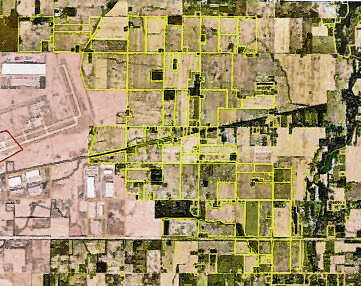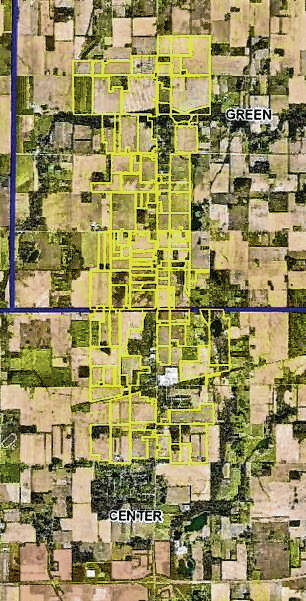
Land parcels outlined in yellow in Buck Creek and Center townships are proposed to be part of a proposed tax increment financing district. The area is just east of an existing tax increment financing district shaded in pink.
HANCOCK COUNTY — The creation of two new special taxing districts moved one step closer to completion this week as county officials hurry to finish ahead of an upcoming state law.
Under the new statute, which goes into effect on July 1, the Indiana Economic Development Corporation can establish innovation development districts. Taxes from new development in such a district would be collected similar to the tax increment financing, or TIF, districts that counties, cities and towns use to collect funds for improving areas targeted for commercial and industrial development.
If the expected total costs and benefits of proposed investment in an innovation development district are over $2 billion, the state can create and manage the district on its own without the involvement of local leadership. If it’s less than $2 billion, state and local leadership would have to enter into an agreement over governing the district, but both scenarios have Hancock County officials concerned about ceding control and tax revenue to the state.
The state would not be able to create an innovation development district in an area in which a local tax increment financing district is already established. That has prompted Hancock County officials to set the groundwork for establishing tax increment financing districts in areas where the state may find an innovation development district tempting.
One of those areas is nearly 4,000 acres in eastern Buck Creek Township and slightly into western Center Township. Another is about 4,620 acres along State Road 9 in Center and Green townships north of Greenfield.

The Hancock County Redevelopment Commission, which oversees the tax increment financing districts in the unincorporated parts of the county, approved measures earlier this month needed to create the districts. The Hancock County Area Plan Commission did so last week, and the Hancock County Board of Commissioners did on Tuesday. The redevelopment commission is slated to have a public hearing on the matter and consider final approval next week.
John Jessup, president of the county board of commissioners, said at Tuesday’s meeting that the new law puts the county “in a defensive posture as far as development that takes place in Hancock County, and to protect the interests of Hancock County and the future revenues of the county, we feel this action is necessary.”
Commissioners Marc Huber and Bill Spalding support the new tax increment financing districts as well.
“At least the TIF helps us to control our own destiny,” Spalding said. “The state cannot TIF over an existing TIF, so this gives us a little bit of a leverage tool to work if it (an innovation development district) ever did come.”
The new law requires a fund to be created for each innovation development district to collect taxes from new development in the district.
At least 12% of the property taxes from new development in an innovation development district would have to go to the local taxing units affected by the district. That leaves Hancock County commissioners concerned over the potential for the rest of the property tax funds from new development in a district going into a statewide innovation development district fund that the law outlines. The law also states that all of the state income and retail taxes from new development in an innovation development district can be transferred to the statewide fund.
“Those are big numbers when you start putting that together,” Huber said.
Nate Day, business manager for Greenfield-Central Schools, told the county commissioners at the recent meeting that the school corporation supports the county’s efforts to encourage growth and economic development.
“As a stakeholder and potential partner in this process, we would like to request that our status as an overlapping taxing district that may be impacted by future TIF districts be considered,” Day added. “We support the use of TIF districts as a targeted economic development tool, but it does affect our school district.”
When a TIF district is created, property taxes based on assessed value up to that point continue going to taxing units like schools and public safety agencies. Property taxes from new development, however, go to the redevelopment commission, which uses the funds to improve the district. The redevelopment commission can give funds to schools and other impacted taxing units, but only for capital needs, not operational ones.
George Langston, a Greenfield resident and frequenter of commissioners meetings, expressed concerns about the new TIF districts.
“I’m concerned about TIF areas because we’re already experiencing in the current TIF areas problems with school funding and public safety,” Langston said. “And by creating two new TIFs, it’s my opinion we’re compounding that problem.”
Huber pointed to the economic development payments the county negotiates with warehouse developers, which can be used for school and public safety operational expenses, to try to rectify that issue.
Jessup noted the state only allows local taxing units to grow their budgets from property taxes by so much despite how much assessed value actually grows by, and added economic development agreements along with tax increment financing can help overcome that.
“If we don’t do TIFs, then the school’s going to get an arbitrary 4.5% growth quotient that’s sent down by the state annually,” Jessup said. “That’s all they’ll ever get. It doesn’t matter if we get 6% growth, 20% growth, 30% growth. We foresee that there’s going to be substantial growth in the area. By utilizing economic development agreements and the RDC (redevelopment commission) paying for capital projects out of those funds, the school will net more than the 4.5% growth quotient. That’s been proven over and over. We can continue to say that TIFs hurt schools, TIFs hurt public safety, but the fact is they don’t. Do your homework; they don’t. They help, and we’re making it better.”




